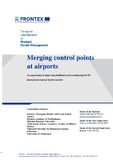Merging control points at airports : An opportunity to improving facilitation and to enhancing the EU internal and external border security
Kokkuvõte
This dissertation aims to ascertain whether merging control points of air border-related activities would have a positive impact in Fundamental Rights of the citizens (mainly facilitation). And at the same time it would enhance the internal and external security of the EU by performing systematic checks against relevant and interoperable databases. Those systematic checks would be done either on passengers,or during job applications vetting procedure.
Kirjeldus
1. Introduction ; 1.1. Considered problem ; 1.2. Aim of the research ; 1.3. Methodology ; 1.4. Research question and sub-questions ; 2. Literature Review ; 2.1. Successful implementation of merging control points ; 2.1.1. Public-Private Cooperation ; 2.1.2. Cooperation between public organisations ; 2.2. Cross-border cooperation ; 2.2.1. Inter-agency cooperation, coordination and collaboration ; 2.2.2. Relevant researches ; 2.3. Risk analysis and classification of passenger influxes ; 2.4. Fundamental Rights relevance in relation with systematic checks on control points ; 3. Research Methodology ; 3.1. Semi Structured interview ; 3.2. Desk Research ; 3.2.1. References in EU norms and documents ; 3.2.2. Interoperability of databases as information exchange tool ; 3.3. Ethics ; 3.3.1. Harm to participants ; 3.3.2. Lack of informed consent ; 3.3.3. Protection of Privacy ; 3.3.4. Data Management ; 3.3.5. Partiality ; 3.3.6. Permission ; 3.3.7. Credibility ; 3.3.8. Transferability ; 3.3.9. Dependability ; 3.3.10. Confirmability ; 4. Analysis and Results ; 4.1. Merging Control Points ; 4.2. Use of systematic checks on merged control points and during vetting procedure ; 4.3. Division of passengers in “innocuous” and “to be screened” influxes ; 4.4. Harm to Confidentiality, Data-Protection and balance of Liberties-Security ; 4.5. Intra-organisational and inter-agency relations and conditionings ; 4.6. Relevance of information exchange, legal obstacles and how to solve barriers ; 5. Discussion of Results, Conclusions and Recommendations



